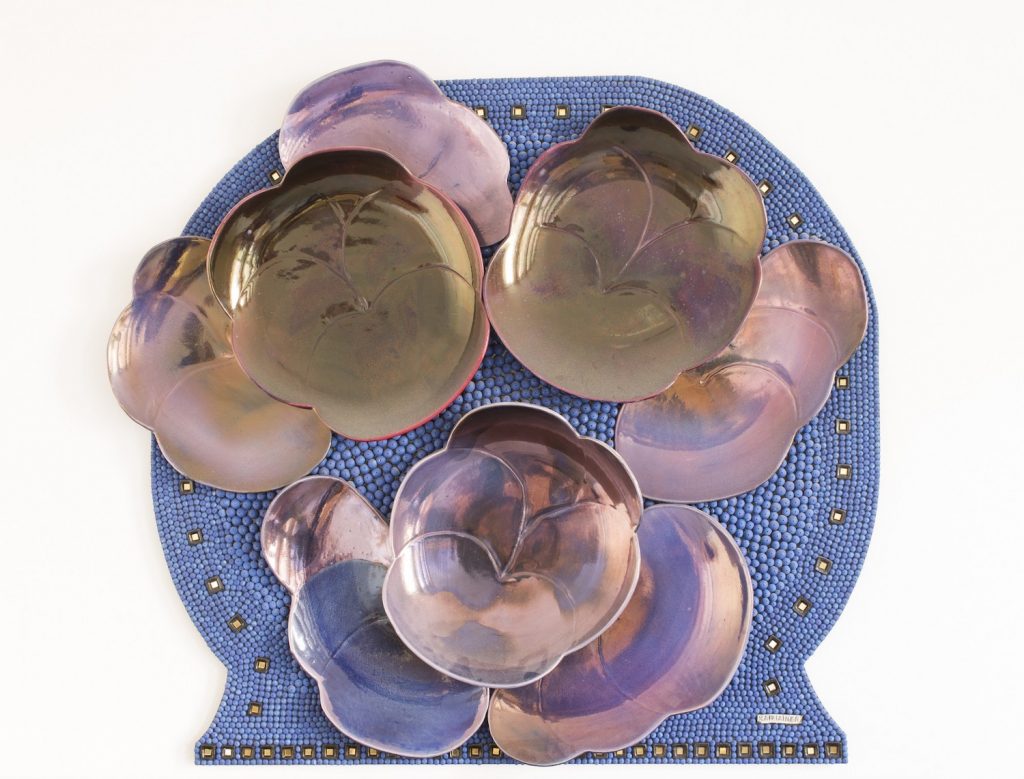Birger Kaipiainen – Violets, in the Parish House of Mänttä
In 1958 the Parish House planned by architect Heimo Kautonen was finished on a piece of land that G. A. Serlachius Ltd. donated to the parish of Mänttä. The house was additionally expanded at the beginning of the 1970s, when the Gösta Serlachius Fine Arts Foundation ordered a relief with violet motifs from ceramic artist Birger Kaipiainen, and deposited it there as a decoration for the new parish hall.
Kaipiainen’s work Violets is still placed on the wall of the parish hall. It is a ceramic relief which is one metre wide and high, whose stylized flower motifs shining in nuances of bluish red come meandering out of their background which is covered in deep blue pearls and pieces of mirror glass.
Birger Kaipiainen (1915–1988) cultivated violets here and there in his production. They sprout in the well known wallpaper the Night of the Larks produced by Pihlgren and Ritola Ltd., and in the vessels of Arabia’s series Paradise, they have a leading role blossoming in tiles and plates with violet motifs, in nuances of blue. In the 1960s they burst into bloom in huge compositions, most spectacularly in the work measuring nine metres called The Sea of Violets, which is in the Council Hall of Tampere.
Most violet species thrive in humid places in half shadow, protected by trees and bushes. Kaipiainen’s ceramic violets have rooted themselves even deeper in tenebrity, in the hidden mental landscape of the artist.
Kaipiainen, who during his career enjoyed artistic freedom at Arabia’s factory, was a very singular artist, who deviated completely from the reductive modernism of his time, in his love for ornaments and exuberance. At a time when designers in general were striving to eliminate all sentimentality and ornamentality, Kaipiainen was doing quite the opposite. In their design language, the three-dimensional plates and wall plates blaze and abound with fruits, birds, flowers and vines.
As is the case with the relief of the Parish House of Mänttä, most of Kaipiainen’s works were unique objects, only a few of them reaching industrial-scale production. The line that is often being drawn between design and art, is difficult to draw in his case. His persisting theme is a fantasy world, with beauty as its focal point.
All fantasy, in which the things you imagine seem more beautiful than reality, also bears within itself a sense of yearning. In the Parish House, over the years, Kaipiainen’s violets have witnessed the very different turning points and feasts of life. You associate them with spring and joy, but they also express a sense of longing in dark nuances and melancholy.
The blossoming relief of this artist, who always sought for beauty in his works, as a work purchase literally describes one of the aims of the Gösta Serlachius Fine Arts Foundation, founded in 1933, which has been to decorate the town of Mänttä with art.
Marja Niemi
Curator


